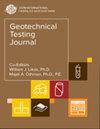细砂先进实验室单调循环三轴试验优化
IF 1.2
4区 工程技术
Q3 ENGINEERING, GEOLOGICAL
引用次数: 0
摘要
单调和循环三轴试验为广泛的岩土工程敏感问题提供了关键信息。本文评估了几种误差源对应力应变测量的潜在影响,并讨论了如何提高测试质量。根据压力水平的不同,外部容积计显示出明显的误差。虽然高分辨率的局部径向应变测量存在相当大的挑战,特别是在长时间的循环测试中,但“浮动”径向带和替代“l配置”系统的问题已被克服,通过步骤可以可靠地解决低至10 - 4%的应变。样品结束条件比通常认为的更为重要。采用光滑的放大和润滑的端板可以避免记录错误的高剪切阻力,这在低有效应力下测试相对松散的试件时最为显著。刚度和膨胀趋势也记录更可靠的试验采用光滑扩大和润滑端板。这种安排克服了显著的应变误差,即使在使用本地仪器和初始高径比为2的试样进行测试时也是如此。本文章由计算机程序翻译,如有差异,请以英文原文为准。
Optimization of Advanced Laboratory Monotonic and Cyclic Triaxial Testing on Fine Sands
Monotonic and cyclic triaxial testing provides key information for a wide range of sensitive geotechnical problems. This paper assesses the potential impact on stress-strain measurements of several error sources and discusses how test quality may be improved. External volume-gauges are shown to be subject to significant errors that depend on pressure level. While high-resolution local radial strain measurement presents considerable challenges, especially in long duration cyclic tests, problems with ‘floating’ radial-belts and alternative ‘L-configuration’ systems were overcome by steps that allow strains as low as 10 -4 % to be resolved reliably. Sample end conditions are shown more important than is commonly appreciated. Employing smooth enlarged and lubricated end platens can avoid the recording of misleadingly high shear resistances, which are most significant with relatively loose specimens tested under low effective stresses. Stiffnesses and dilation trends were also recorded more reliably in tests employing smooth enlarged and lubricated end platens. The arrangements overcome significant strain errors even in tests employing local instruments and specimens with initial height-to-diameter ratios of two.
求助全文
通过发布文献求助,成功后即可免费获取论文全文。
去求助
来源期刊

Geotechnical Testing Journal
工程技术-地球科学综合
CiteScore
3.10
自引率
12.50%
发文量
53
审稿时长
3.6 months
期刊介绍:
The purpose of the Geotechnical Testing Journal is (1) to provide a high-quality publication that informs the profession of new developments in soil and rock testing and related fields; (2) to provide a forum for the exchange of information, particularly that which leads to the development of new test procedures; and (3) to stimulate active participation of the profession in the work of ASTM International Committee D18 on Soil and Rock and related information.
The editorial scope of this journal covers test methods for soil and rock, sampling, nomenclature, and practices relating to the determination of properties and behavior of soil and rock for engineering purposes, and for soil as a medium for plant growth.
 求助内容:
求助内容: 应助结果提醒方式:
应助结果提醒方式:


